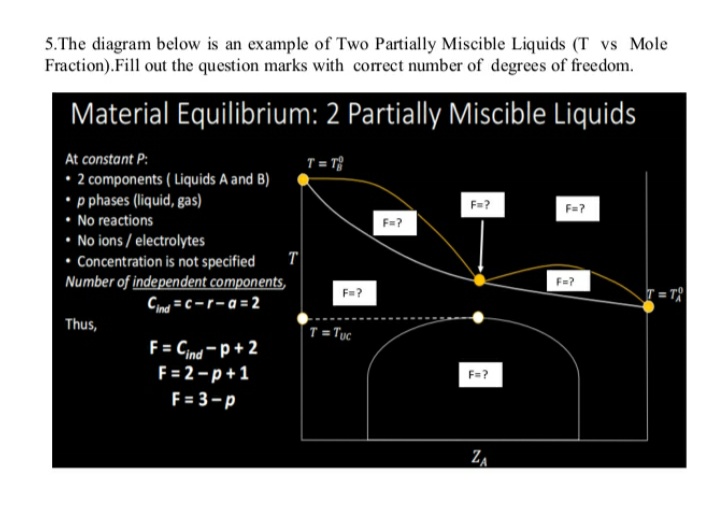5.The diagram below is an example of Two Partially Miscible Liquids (T vs Mole Fraction).Fill out the question marks with correct number of degrees of freedom. Material Equilibrium: 2 Partially Miscible Liquids At constant P: T = T8 • 2 components ( Liquids A and B) • p phases (liquid, gas) • No reactions • No ions / electrolytes • Concentration is not specified Number of independent components, Cing = c-r-a = 2 F? Fa? F? T F=? F? Thus, T = Tục F= Cind -p+ 2 F = 2-p+1 F= 3-p F=? ZA
5.The diagram below is an example of Two Partially Miscible Liquids (T vs Mole Fraction).Fill out the question marks with correct number of degrees of freedom. Material Equilibrium: 2 Partially Miscible Liquids At constant P: T = T8 • 2 components ( Liquids A and B) • p phases (liquid, gas) • No reactions • No ions / electrolytes • Concentration is not specified Number of independent components, Cing = c-r-a = 2 F? Fa? F? T F=? F? Thus, T = Tục F= Cind -p+ 2 F = 2-p+1 F= 3-p F=? ZA
Chemistry: Principles and Reactions
8th Edition
ISBN:9781305079373
Author:William L. Masterton, Cecile N. Hurley
Publisher:William L. Masterton, Cecile N. Hurley
Chapter10: Solutions
Section: Chapter Questions
Problem 64QAP: Carbon tetrachloride (CCl4) boils at 76.8C and has a density of 1.59 g/mL. (a) A solution prepared...
Related questions
Question

Transcribed Image Text:5.The diagram below is an example of Two Partially Miscible Liquids (T vs Mole
Fraction).Fill out the question marks with correct number of degrees of freedom.
Material Equilibrium: 2 Partially Miscible Liquids
At constant P:
T= T
• 2 components ( Liquids A and B)
• p phases (liquid, gas)
• No reactions
• No ions / electrolytes
Concentration is not specified T
Number of independent components,
Cing = c -r-a = 2
F=?
F=?
Fm?
F=?
T = T
F=?
Thus,
T = Tuc
F = Cind -p+ 2
F= 2-p+1
F=?
F= 3-p
ZA
Expert Solution
This question has been solved!
Explore an expertly crafted, step-by-step solution for a thorough understanding of key concepts.
This is a popular solution!
Trending now
This is a popular solution!
Step by step
Solved in 3 steps with 3 images

Knowledge Booster
Learn more about
Need a deep-dive on the concept behind this application? Look no further. Learn more about this topic, chemistry and related others by exploring similar questions and additional content below.Recommended textbooks for you

Chemistry: Principles and Reactions
Chemistry
ISBN:
9781305079373
Author:
William L. Masterton, Cecile N. Hurley
Publisher:
Cengage Learning

Chemistry: Principles and Practice
Chemistry
ISBN:
9780534420123
Author:
Daniel L. Reger, Scott R. Goode, David W. Ball, Edward Mercer
Publisher:
Cengage Learning

General Chemistry - Standalone book (MindTap Cour…
Chemistry
ISBN:
9781305580343
Author:
Steven D. Gammon, Ebbing, Darrell Ebbing, Steven D., Darrell; Gammon, Darrell Ebbing; Steven D. Gammon, Darrell D.; Gammon, Ebbing; Steven D. Gammon; Darrell
Publisher:
Cengage Learning

Chemistry: Principles and Reactions
Chemistry
ISBN:
9781305079373
Author:
William L. Masterton, Cecile N. Hurley
Publisher:
Cengage Learning

Chemistry: Principles and Practice
Chemistry
ISBN:
9780534420123
Author:
Daniel L. Reger, Scott R. Goode, David W. Ball, Edward Mercer
Publisher:
Cengage Learning

General Chemistry - Standalone book (MindTap Cour…
Chemistry
ISBN:
9781305580343
Author:
Steven D. Gammon, Ebbing, Darrell Ebbing, Steven D., Darrell; Gammon, Darrell Ebbing; Steven D. Gammon, Darrell D.; Gammon, Ebbing; Steven D. Gammon; Darrell
Publisher:
Cengage Learning

Principles of Modern Chemistry
Chemistry
ISBN:
9781305079113
Author:
David W. Oxtoby, H. Pat Gillis, Laurie J. Butler
Publisher:
Cengage Learning

Chemistry by OpenStax (2015-05-04)
Chemistry
ISBN:
9781938168390
Author:
Klaus Theopold, Richard H Langley, Paul Flowers, William R. Robinson, Mark Blaser
Publisher:
OpenStax

Chemistry: An Atoms First Approach
Chemistry
ISBN:
9781305079243
Author:
Steven S. Zumdahl, Susan A. Zumdahl
Publisher:
Cengage Learning